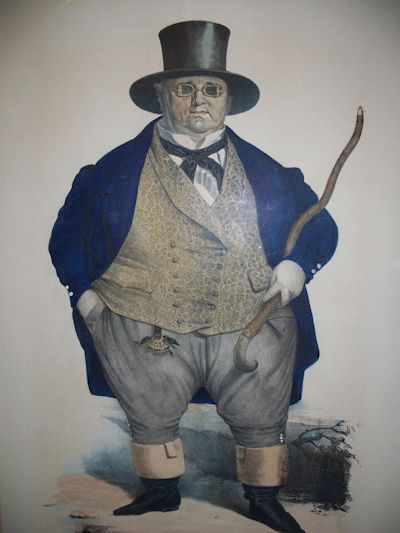William Ball alias John Bull.

Born at Horsehay, near Dawley, on the eighth day of July 1795. William Ball developed into such colossal dimensions as to earn immortal fame.
Mr. Ball was a local curiosity on account of his extraordinary dimensions and great weight of body.
At eight years of age he commenced work as a Puddler for the Coalbrookdale Company at Horsehay. He was a fine lad, and at his occupation, grew in stature to such an extent that a platform or scaffolding had to be erected to enable him to reach his work.
Later, with the same company, he became a Shingler and as a Shingler flourished for some twenty years until unfortunately, a serious accident to his left eye prevented him from following his employment.
In 1845, when 50 years old, he weighed 32 stone ten pounds. His girth was six feet, three inches, his thigh three feet in circumference and his arm twenty inches, whilst he stood 5 feet 9½ inches high.
Not content with these figures however, he continued to expand, and a photograph taken of him portraying the character of “John Bull” had the following inscription:- “An Englishman am I – W. Ball, alias John Bull. Born at Horsehay, Shropshire, July 8th 1795. Worked forty years Puddler and Shingler for the celebrated Coalbrookdale Company of Ironmasters. Height 5 feet 9½ inches. Circumference of neck 23½ inches. Arm 27 inches, breast 70 inches, stomach 80 inches, thigh 50½ inches, calf of leg 25 inches and exceeded 40 stone weight. Healthy and very active”.
So strong was William Ball, that as a feat of strength, he once placed under the forge hammer – without any assistance of machinery – a piece of iron taken from the ball furnace weighing nearly 9 hundredweight.
His waistcoat was of such dimensions that three young men were buttoned at one time within it.
He was remarkably active, and very jocular in society; his conversation was full of anecdote, and his manners easy and unassuming, combined with a very retentive memory and natural pleasantry of disposition.
He was twice married and had two children by his first wife.
There was great rejoicings in Horsehay and the neighbourhood in 1850 on the occasion of the birth of Mr. Alfred Darby.
A procession was formed at Horsehay, and paraded the district, headed by “Big Billy Ball” as the biggest man in the employ of the Coalbrookdale Company, and little Bennie Poole as the smallest.
For the purpose of comparison, both were hoisted by pulley-blocks, the former on to a powerful horse, and the latter on to a pony.
As “Billy” was being mounted on to his steed he exclaimed “Dunner yo drop me”. Had that occurred, there might have been a subsidence.
The poor horse it has been said over the years had to be destroyed in consequence of a broken back.
It is recorded that William Ball went to London for the Great Exhibition in 1851, which would certainly have been incomplete without him.
He travelled in the guard’s van – for a very good reason – and at Birmingham some city gentlemen who also got in, poked fun at Mr. Ball.
They inquired of him as to the quantity and cost of the material with which to make him a suit, but after he told them that if they would take him to a tailor, have him measured and pay for a suit, he would give them the information required; they troubled him no more.
In London he became an easy victim of the “sharpers”, (people who practice low -down trickery intended to advantage them-selves), and was robbed without pity. The following summer William Ball died in his fifty seventh year. There was a large crowd at Doseley Churchyard for the funeral. The coffin which more resembled a corn-coffer, was first occupied by ten venturesome lads.
Sixteen fellow workmen with straps and poles were required to carry William Ball, the John Bull of Shropshire to his last resting place.
Written by A.W. Bowdler.